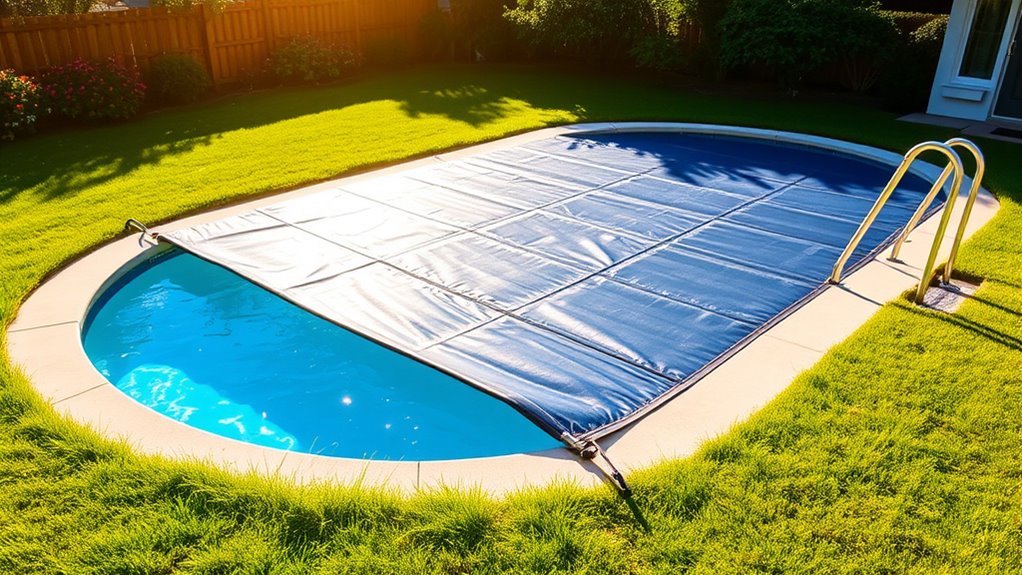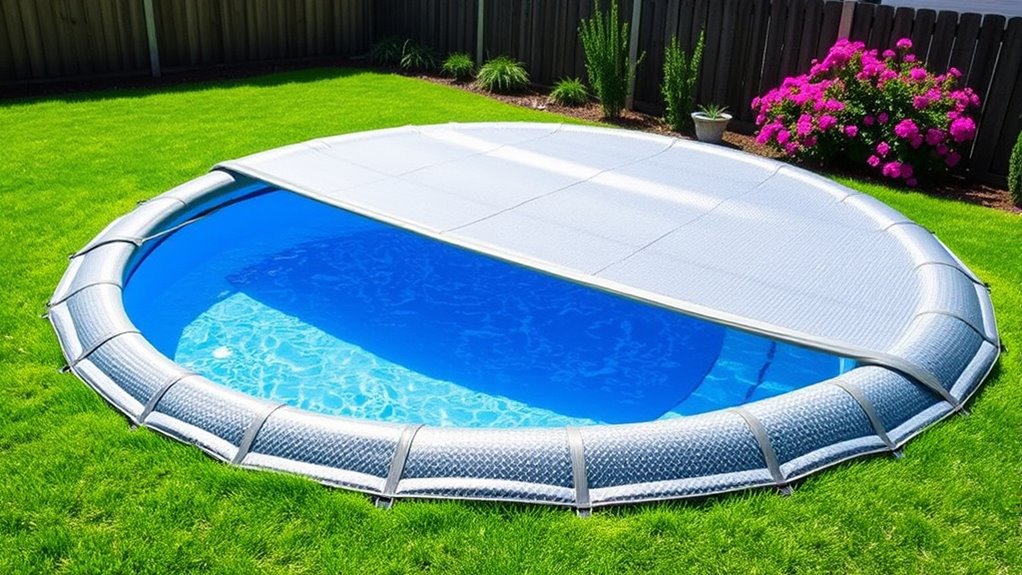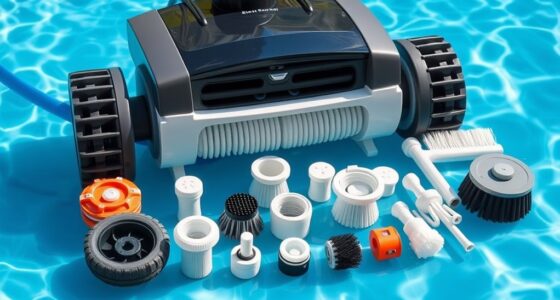Pool safety covers are essential for keeping your pool safe from accidental falls, debris, and algae growth. They come in different types, like mesh, solid, and automatic, each offering unique benefits. Mesh covers let rainwater through but block debris, while solid covers prevent water from entering, which helps reduce maintenance. Automatic covers provide quick access and ease of use. To find out which cover suits your needs best, you’ll want to explore the various options available.
Key Takeaways
- Pool safety covers prevent accidental falls by acting as barriers for children and pets, enhancing overall safety.
- Mesh covers allow rainwater to pass through, while solid covers prevent water passage, reducing maintenance and algae growth.
- Automatic safety covers offer convenience for quick access and easy use, making them a popular choice for busy households.
- Regular maintenance and inspection are essential to ensure the effectiveness and longevity of pool safety covers.
- Investing in quality safety covers, like LOOP-LOC, provides peace of mind with durable materials that meet safety standards.

When it comes to protecting your pool, investing in a safety cover is fundamental. There are various types of pool safety covers to contemplate, each with unique features that suit different needs.
Mesh safety covers allow rainwater to pass through while keeping debris out. They’re generally less expensive and easier to install than solid covers. Solid safety covers, on the other hand, prevent water from passing through, which helps reduce evaporation and algae growth. Although they provide a solid barrier, they may require more maintenance.
Mesh safety covers are cost-effective and easy to install, while solid covers excel at reducing evaporation and algae growth.
Automatic safety covers offer convenience with their mechanical operation, allowing for quick installation and removal. You can easily open or close them, making access to your pool simple.
LOOP-LOC covers are known for their durable materials and ability to support significant weight in emergencies. This can give you peace of mind, knowing that your cover can handle unexpected situations. The material construction varies among cover types, with mesh covers providing breathability while solid covers protect against sunlight.
One of the most significant safety features of pool covers is their ability to prevent accidental falls. They act as a barrier, keeping children and pets safe from falling into the pool. Both mesh and solid covers do a great job of protecting your pool from debris like leaves and twigs, which reduces your maintenance needs. Solid covers also minimize UV penetration, helping to prevent algae growth.
Top models like LOOP-LOC covers meet or exceed safety standards, offering reliable support during emergencies.
Installing a safety cover requires attention to detail. It’s essential to properly place anchors, securing straps and springs to confirm the cover is tightly fastened. The cover should overlap the pool deck by 12 to 18 inches to be effective.
Automatic covers should extend smoothly across the pool with minimal noise, while tight securing is critical to prevent unauthorized access. In some cases, you might want to seek professional help for complex installations.
Regular maintenance and inspection of your safety cover are imperative to confirm its effectiveness. Inspecting for damage or wear helps you catch issues before they become major problems. Keeping your cover clean will also prolong its life and effectiveness.
Frequently Asked Questions
How Do I Choose the Right Size for My Pool Cover?
To choose the right size for your pool cover, start by measuring your pool accurately. For rectangular pools, measure the length and width.
If your pool has a complex shape, use triangulation techniques. Don’t forget to account for any obstructions like steps or ladders.
Make certain your measurements are precise to guarantee a snug fit. You might even opt for a slightly larger size for rounded pools to ensure adequate coverage.
Can I Install a Safety Cover Myself?
Sure, you can absolutely install a safety cover yourself! Just grab a tape measure, some tools, and channel your inner DIY guru.
What’s the worst that could happen? Oh right, a potential pool disaster! While it sounds adventurous, remember that precise measurements and secure anchoring are essential.
If you’re up for a challenge, go for it! But if you’d rather avoid the drama, hiring a professional might save you some headache—and your pool’s safety.
What Maintenance Is Required for Safety Covers?
To maintain your safety cover, check it regularly for damage like tears or frayed edges.
Keep it tight to avoid sagging and inspect hardware for wear.
Clean it periodically to remove debris, and monitor the pool water level, especially after heavy rain.
Don’t walk on the cover unless it’s an emergency, and verify it meets ASTM standards.
Regular maintenance helps extend the cover’s lifespan and guarantees safety for everyone around the pool.
How Long Do Safety Covers Typically Last?
Ah, the ephemeral nature of time!
Safety covers typically last between 1 to 15 years, depending on their type and care.
Mesh security covers endure about 10-15 years, while solid ones last around 6-10 years.
Automatic covers may need replacements after just 3 years.
Environmental factors, material quality, and how often you use them all play vital roles in determining their lifespan.
Regular maintenance can greatly extend their durability, so stay proactive!
Are There Warranties Available for Pool Safety Covers?
Yes, there are warranties available for pool safety covers.
Manufacturers often offer warranties ranging from 12 to 15 years, depending on the type and brand.
To keep your warranty valid, you’ll need to register it shortly after purchase.
Remember, warranties typically don’t cover damage from improper use, installation, or chemical issues, so it’s essential to follow care guidelines.
Regular maintenance can help guarantee your cover lasts and remains under warranty.
Conclusion
To sum up, investing in a pool safety cover isn’t just a smart choice; it’s a lifesaver. Did you know that an estimated 3,536 people drown in the U.S. each year, with many incidents involving children under five? By using a safety cover, you greatly reduce the risk of accidental drownings and keep your loved ones safe. So, don’t wait—make your pool a safer place today and enjoy peace of mind all year round!









